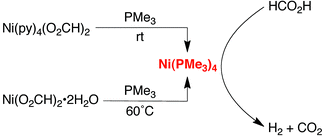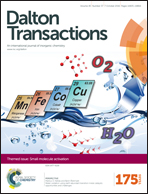Nickel-catalyzed release of H2 from formic acid and a new method for the synthesis of zerovalent Ni(PMe3)4†
Abstract
Ni(PMe3)4 serves as a catalyst for the release of H2 and CO2 from formic acid. The capacity of Ni(PMe3)4 to achieve this transformation is linked to the ability of the PMe3 ligand to induce decarboxylation, as illustrated by the observation that both Ni(py)4(O2CH)2 and Ni(O2CH)2·2H2O react with PMe3 to afford Ni(PMe3)4; the latter transformation also provides a convenient method for the synthesis of a zerovalent nickel compound.

- This article is part of the themed collection: Small Molecule Activation

 Please wait while we load your content...
Please wait while we load your content...